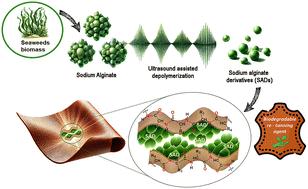生物可降解的海藻酸盐衍生物通过环保超声波技术获得更可持续的皮革鞣制†
IF 9.2
1区 化学
Q1 CHEMISTRY, MULTIDISCIPLINARY
引用次数: 0
摘要
本研究利用不同的超声技术和不同的关键工艺参数,包括超声频率、强度和处理时间,在维持温度为40°C的条件下,研究了从海藻酸钠中提取的10种可生物降解的再鞣剂。通过粘度分析、凝胶渗透色谱(GPC)、质子核磁共振(1H-NMR)、热重分析和衰减全反射傅里叶变换红外(ATR-FTIR)光谱对海藻酸钠衍生物(SADs)进行了表征。研究结果表明,超声波主要促进聚合物链内1-4键的断裂。SADs -胶原基质的热稳定性受SADs的分子量、黏度以及胶原基质的异质性的影响。随后,在中试规模上评估了最有效的复晒过程SAD。所生产的皮革通过物理化学方法(微差扫描量热法、单侧核磁共振、ATR-FTIR)和标准测试进行了全面的表征。值得注意的是,所选的SAD完全取代了现有的商业产品,如丙烯酸树脂和合成复鞣剂,产生了天然柔软的白色皮革,保持了高端鞋类和皮革制品所需的技术性能特征,如撕裂强度、表面耐久性、颗粒膨胀和色牢度。此外,这种方法通过消除对染色过程的需要,为人类健康和生态系统提供了更大的优势。本文章由计算机程序翻译,如有差异,请以英文原文为准。

Biodegradable alginate derivatives obtained by eco-friendly ultrasound technology for more sustainable leather tanning†
This study investigates ten biodegradable re-tanning agents derived from sodium alginate, utilizing various ultrasound technologies and varying key process parameters, including ultrasound frequency, intensity, and treatment duration, at a maintained temperature of 40 °C. The sodium alginate derivatives (SADs) were characterized through viscosimetric analysis, gel permeation chromatography (GPC), proton nuclear magnetic resonance (1H-NMR) spectroscopy, thermogravimetric analysis, and attenuated total reflectance Fourier-transform infrared (ATR-FTIR) spectroscopy. The findings demonstrate that ultrasound primarily facilitates the cleavage of 1–4 linkages within the polymer chains. The thermal stability of SAD-collagen matrices was influenced by the molecular weight and viscosity of the SADs, along with the intrinsic heterogeneity of the collagen matrix. Subsequently, the most effective SAD for the re-tanning process was evaluated at a pilot scale. The leather produced underwent comprehensive characterization through physical–chemical methods (micro-differential scanning calorimetry, unilateral NMR, ATR-FTIR) and standard tests. Notably, the selected SAD fully replaced existing commercial products, such as acrylic resins and synthetic re-tanning agents, resulting in white leather with a natural softness that maintains the technical performance characteristics, such as tear strength, surface durability, grain distention, and colour fastness, required for high-end footwear and leather goods. Additionally, this approach offers enhanced advantages for both human health and the ecosystem by eliminating the need for dyeing processes.
求助全文
通过发布文献求助,成功后即可免费获取论文全文。
去求助
来源期刊

Green Chemistry
化学-化学综合
CiteScore
16.10
自引率
7.10%
发文量
677
审稿时长
1.4 months
期刊介绍:
Green Chemistry is a journal that provides a unique forum for the publication of innovative research on the development of alternative green and sustainable technologies. The scope of Green Chemistry is based on the definition proposed by Anastas and Warner (Green Chemistry: Theory and Practice, P T Anastas and J C Warner, Oxford University Press, Oxford, 1998), which defines green chemistry as the utilisation of a set of principles that reduces or eliminates the use or generation of hazardous substances in the design, manufacture and application of chemical products. Green Chemistry aims to reduce the environmental impact of the chemical enterprise by developing a technology base that is inherently non-toxic to living things and the environment. The journal welcomes submissions on all aspects of research relating to this endeavor and publishes original and significant cutting-edge research that is likely to be of wide general appeal. For a work to be published, it must present a significant advance in green chemistry, including a comparison with existing methods and a demonstration of advantages over those methods.
 求助内容:
求助内容: 应助结果提醒方式:
应助结果提醒方式:


